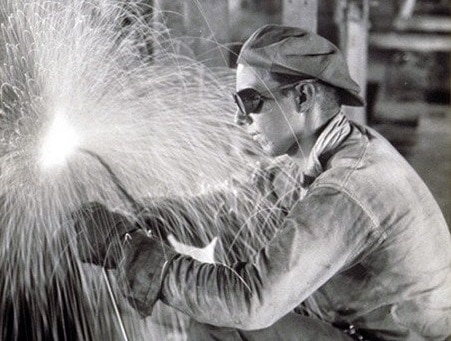
A couple weeks ago, I outlined and (hopefully) debunked four common myths about skilled labor. While these stereotypes about blue collar work may have been true 50 years ago, they simply aren’t the case in today’s world.
In the 90s and early 00s, everything was about the business world. Wall Street was going gangbusters, this new fangled thing called the internet was taking off, and dream jobs were those in which you sat in an office with a computer and made millions. Those jobs were not terribly difficult to come by. Today’s youth have those same notions of where the good jobs are, but nowhere near the same success in finding them. While the job market is improving from the economy’s nosedive six years ago, it’s still not what it was pre-recession, especially for new college graduates, for whom the unemployment rate is at 8.5%, versus 5.8% for the workforce as a whole. It’s time young people looked outside the white collar box when it comes to landing a steady, good paying job.
My aim with this article is to convince you that blue collar jobs are in fact what some young men ought to aspire to, just like they aspire to be a lawyer or banker. I’m not trying to convince you that blue collar jobs are better (though in some cases they will be, just as in some cases white collar jobs will be better), but that they are simply on par with office jobs by nearly every measurable factor in terms of what makes a career a “good” one. That’s the stereotype that most needs breaking — that blue collar careers are beneath white collar ones and less desirable. The simple reality is that they aren’t, and here are 5 good reasons why:
1. Trade School: Cheaper & Shorter
One of the biggest benefits to working in the skilled trades is the education required. While there are many positives to going to 4 years of school for a bachelor’s degree, there are also a few big negatives, including cost. Since 1990, tuition costs have risen over 300%, far outpacing the growth of the economy. When costs rise at 7-8% per year, while inflation grows 2-3% per year, you end up with a product that becomes unaffordable. For many folks, though, that unaffordability isn’t standing in the way, because student loans are easy to come by. Because of that, about 2/3 of students with bachelor’s degrees are leaving college with debt that averages $26,000 per student. That’ll make for a $300 monthly payment for a decade. (From experience, it’s a little depressing when your student loan bill is more than your car payment.) All in all, your average bachelor’s degree is likely going to cost you over $100,000 — closer to $150k if completely financed through loans.
The vast majority of training programs for the skilled trades, on the other hand, last from 6 months to 2 years, and will cost just over $30,000. Even if that cost is entirely financed by student loans, you’re looking at a total of $40,000, which is still a savings of at least $110k!
This makes for a huge opportunity cost for those going to 4-year colleges. You’re spending an extra 2-3 years in school, paying tens of thousands per year, while the tradesman is already graduated and earning money (in some cases, making six figures as a 21-year-old).
One final factor is simply that some 18-year-olds aren’t ready for a college environment. You’re thrown off the cliff from your warm and comfortable home life into total independence. It’s not an easy transition for anyone; in fact, about 40% of all undergrad enrollees will drop out before earning a degree.
Trade school offers a nice on-ramp to independence. You’ll often stay close(r) to home, you receive real-world, hands-on training from the get-go, and you aren’t spending every waking moment with folks your same age and in the same position in life (which can make for a difficult social transition once out of college). Again, there are certainly benefits to attending a 4-year university (we’ve outlined the pros and cons here), but the big pros of trade school are that you’ll save a lot on tuition, start being able to make money sooner, and can start taking measurable steps towards adulthood more quickly.
2. Compensation: Trades Jobs Are Well-Paying
Even those who are concerned about the hefty price tag of college still feel that while the cost may be high, it’s always worth it, since it will increase their lifetime earnings potential.
This worry over compensation definitely looms looms large in holding teenagers back from considering trades work. And while money is not the most salient factor in determining a career, it is certainly important. The assumption is that the income ceiling is higher for white collar work than it is for blue collar. And frankly, in an absolute sense, that’s true. Those who are pulling in a million a year aren’t tradesman; the vast majority are college graduates. But these very wealthy individuals represent a miniscule percentage of the workforce.
If we look at averages, which is where most of us are and will be in terms of our career, the paychecks for trades are either at or above other careers. One study of the trades from just the state of Michigan found the above to be true — that the ceiling was higher for white collar, but the median was actually higher for blue collar. The range for the skilled trades (per hour) was $13-$34, for a median of $21/hour. For all other occupations, the range was $8-$39, for a median of $16/hour.
Now, could those numbers be skewed, especially on the low-end, by workers who only have a high school education? Absolutely. So what happens if we just compare national averages for wages earned by college educated white collar employees and tradesmen? They’re almost the same, with white collar folks coming in at $1,000 more per year. Over the course of a 40-year career, that ends up as a fair amount of money. But when you factor in college costs, plus a few more years in the workforce, that difference actually begins to favor the blue collar worker.
Let’s take a look at the starting salaries of the largest skilled trades careers, and you’ll see they match up against the average starting salary for college grads (which is reported to be $48,000 – and let me tell you, I don’t know a single bachelor’s degree holder who started out at that high of a salary!).
- Maintenance Mechanic: $38,000
- Aircraft Mechanic: $49,000
- Sheet Metal Mechanic: $47,000
- Driver: $51,000
- Electrician: $44,000
- Painter: $35,000
- Machinist: $37,000
- Pipefitter: $49,000
Remember, those are the most common blue collar jobs. If you look at the higher end of trades work, you’ll see wages that are much higher than college grads:
- Locomotive Engineer: $63,000
- Elevator Repairer/Installer: $73,000
- Subway Operator: $60,000
- Nuclear Technician: $69,000
- Aerospace Operations: $61,000
Remember, these are base salaries that come just as a result of your having the proper skills. Just like with white collar work, there are many trades fields in which you can move up the ladder and earn far more. If you show management skills and big picture vision, you’ll receive promotions and raises, just as you would in an office setting. You can also start your own business, and use your entrepreneurial, creative, and customer service skills to set yourself apart from the pack, at which point your income potential is as high as your ability to hustle.
You may be surprised to learn that being a tradesman could get into that somewhat hallowed six-figure salary range in far less time, and with far less money spent on schooling, than just about any other field of work. And you could possibly make even more than that; think a plumber can’t make a million bucks a year? Think again!
Beyond wages, there are many other factors that actually play a more important role in workplace satisfaction. Which leads to our next point…
3. Job Security: The Skilled Trades Can’t Be Outsourced

Photo Source: Foster Jacob Electrical Contracting
Compensation is important, but only the third most important factor in overall job satisfaction. The first is actually “opportunity to use skills and abilities” (more on that below) and the second is job security. So while pay in the trades may be commensurate with white collar work, for some, these other factors will boost this type of work ahead of occupying a cubicle.
In our new economy, complete job security just doesn’t exist. Anything can happen to any company, and you can be let go. But some jobs are a lot more secure than others. Information and tech jobs are particularly vulnerable to being taken over by robots or moved overseas, but even once-secure jobs in the medical and legal sectors have begun to be outsourced as well.
The trades, on the other hand, simply cannot be outsourced. While the world may not always need bloggers, it will always need mechanics, electricians, plumbers, welders, etc. When you’re locked out of your house, you won’t phone a customer service line and deal with robots trying to resolve your issue, you’ll call a locksmith (unless of course you can pick your own lock!). The roads and bridges in this country will always be built here. Our skyscraper projects won’t be constructed in France and shipped over (that was a one-time deal with Lady Liberty). While jobs in the information/tech/customer service sectors can always be shipped away, the careers that require literal hands-on work cannot be.
One of the points that Mike Rowe hammers home in his book, Profoundly Disconnected, is that Americans are disconnected from the things that keep our lives and society running on a daily basis (hence the title of the book). Without the trades, our society would literally crumble. Roads/bridges would go into disrepair. Cars would break down and not be fixed, and new cars wouldn’t be made to replace them. Our electrical grid would shut down and we’d lose power. Plumbing would break down or back up, and we’d all be swimming in our own waste. Not a pretty picture, is it? It may seem sort of dystopian, but in fact our infrastructure is falling apart before our eyes. The American Society of Civil Engineers rates it as a D+. 60 Minutes, just this week, did a feature on America’s crumbling infrastructure. This is an incredibly salient issue. Without more skilled tradesmen, it will only get worse.
Of course, as 60 Minutes points out, politicians need to fund these projects, to pay these tradesmen, to fix our decaying roads and bridges, but that’s a whole ‘nother subject. Yet even if these projects don’t get funded for a long time…
Listen to my podcast with Mike Rowe about the trades:
4. Availability: There Are Plenty of Jobs For the Taking
Trades jobs are not only very secure, there’s a whole lot of openings for them as well.
In the last post I briefly mentioned the skills gap here in America – the state of having more jobs available than workers who are trained and able to take those jobs. A big part of that reality is simply that there are more tradesmen retiring than entering the field. Among all jobs in the US, workers aged 25-44 make up about 48% of the workforce; among skilled trades jobs that number is 46%, a mere 2-point difference. When you look at the 45-54 age range the picture is very different. That group makes up 23% of the general workforce, but 32% of skilled trades, meaning that millions more tradesmen will be retiring in the next 15 years than white collar professionals.
For the blue collar worker, there are jobs to be had. They may not be in your city of choice, but that’s a reality faced by much more than just tradesmen. Certain industries flock to certain geographical regions (show biz and Hollywood, fashion and NYC, etc.), so to be successful you may have to move. According to some estimates (including Mike Rowe and his foundation, which works to put tradesmen in good careers), there are literally millions of unfilled jobs right now in the skilled trades, with many more to be created in the years to come.
In fact, in just the next two years, an expected 2.5 million middle-skill jobs (those that require less than a bachelor’s degree but more than a high school diploma) will be added to the workforce, accounting for an incredible 40% of all job growth. The city of Houston alone is expected to add 100,000 jobs in that same time period. North Dakota is in the midst of a petroleum boom, requiring not just oil/gas tradesman, but also electricians, plumbers, carpenters, etc. to build up the infrastructure. Atlanta has a booming film industry that employs almost 80,000 people, with many more needed for the technical aspects like setting up lighting and sound, set construction, etc.
All over the country, the skilled tradesman is in demand.
5. Intangibles: The Satisfaction of Blue Collar Work

Above, I mentioned that the number one factor in overall job satisfaction is being able to use your skills and abilities. It was in 2012 when that factor overtook job security for the first time, just four years removed from the economy crashing. People are quickly discovering that feeling happy and fulfilled at work is incredibly important.
Do you want to spend 40 years of your life bored and dissatisfied for most of your day? Obviously not. But that’s what 70% of Americans feel at work, with highly educated people actually being more likely to be disengaged with their workplace. While boredom can obviously happen at any job, the tradesman who’s working with his hands all day simply has less opportunity for disengagement, as boredom at work often happens when there just isn’t enough to do. Idleness is not often a problem for the blue collar man.
In the last article, I mentioned the false notion that one has to “follow your passion” in order to be happy at work. This is often taken to mean that you should find something you enjoy, then acquire skills in that field. Actually, it works the other way around; find a way to use your skills, no matter what those skills are, and you’ll be passionate about your work. I won’t go into that at length here, but give that section a read from the previous piece.
Other intangibles to be mentioned are things like autonomy at work and work/life balance. In an age where most people’s jobs are accessible by internet and smartphone, disconnecting from work is hard to do. You see emails come in at night, and you respond almost without thinking about it. You hop on the computer for a second, and it turns into an hour or two of work because it’s right there, and seems urgent. You become a slave to email, and to your higher-ups, even if that’s not the intention. When you work with your hands, you can come home at night and actually disconnect from your job. You aren’t always “plugged in,” which gives you a better chance to refresh your body and mind for the next day’s work. Of course, you can choose to work after hours if you’d like – but you’ll also be able to charge your customers a premium for your services if you do!
One final factor is simply the satisfaction that can come from doing something tangible and concrete with your time. Fixing things, building things, seeing the actual, physical fruit of your labor; this is often far more personally fulfilling than spending 8 hours on an excel spreadsheet. As author Matthew Crawford notes in a great article in the New York Times, “Many of us do work that feels more surreal than real. Working in an office, you often find it difficult to see any tangible result from your efforts. What exactly have you accomplished at the end of any given day? Where the chain of cause and effect is opaque and responsibility diffuse, the experience of individual agency can be elusive.” In fact, in our modern economy, 40% of jobs are related to coordinating and mediating rather than actually doing something directly.
The woodworking hobbyist pursues this pastime because it feels really good to build something. The tinkerer of cars loves doing it because he can see something dead come to life, as a product of his own two hands. There is a satisfaction and fulfillment that comes from manual work that simply cannot be achieved in any other setting. For some folks, manual work will remain a fruitful hobby, but for others, it can blossom into a meaningful and long-lasting career.
Conclusion
When we’re weighing which types of jobs to apply for, or even which to accept from multiple offers should we be so lucky, the differentiators often come down to benefits. Pay, job security, balance, work environment, etc. For too long the skilled trades have been neglected as not having any benefits. Thankfully, the tide is turning, and people are starting to see that blue collar work offers some real advantages over white collar work. There are jobs available, pay is good, job security is excellent, and the satisfaction may be greater than being in the information industry.
In some cases and for some people, better jobs and benefits will come as a result of a 4-year degree and being in an office setting. That’s just fine. But for some folks, that’s just not the case. My hope is that the young men reading this, as well as the seasoned men considering a career move, will weigh all their options, and determine what’s best for them and their future.
Read the Entire Series
4 Myths About the Skilled Trades
5 Benefits of Working in the Skilled Trades
How to Start a Career in the Trades







